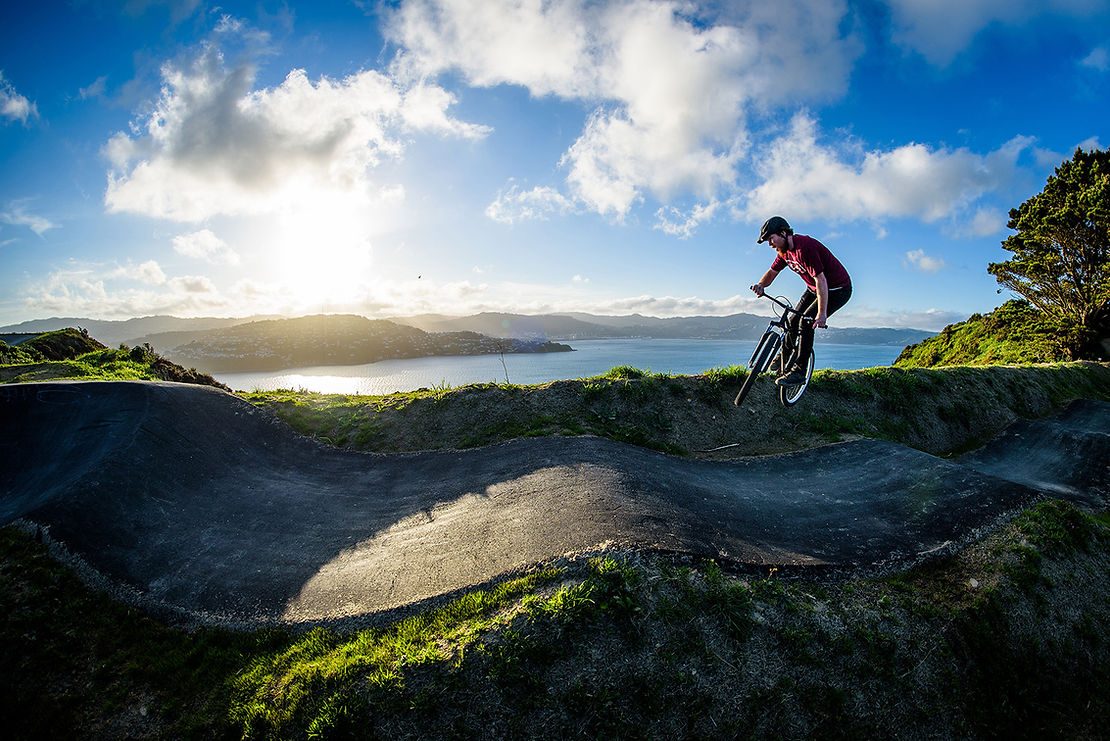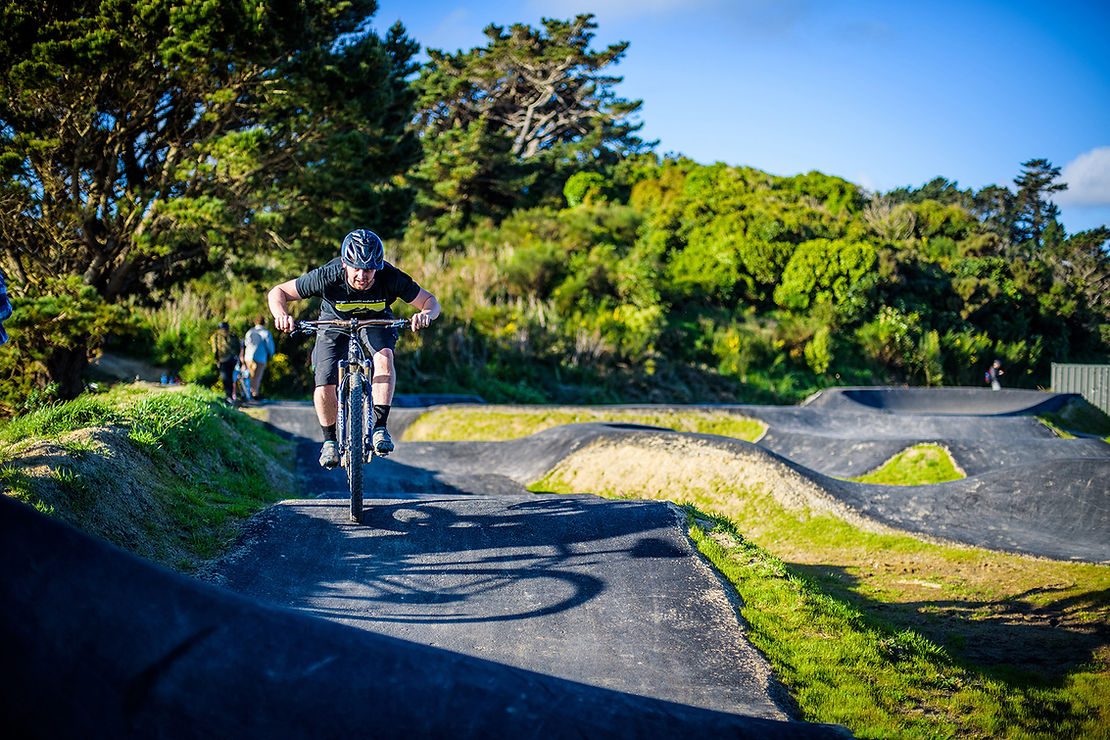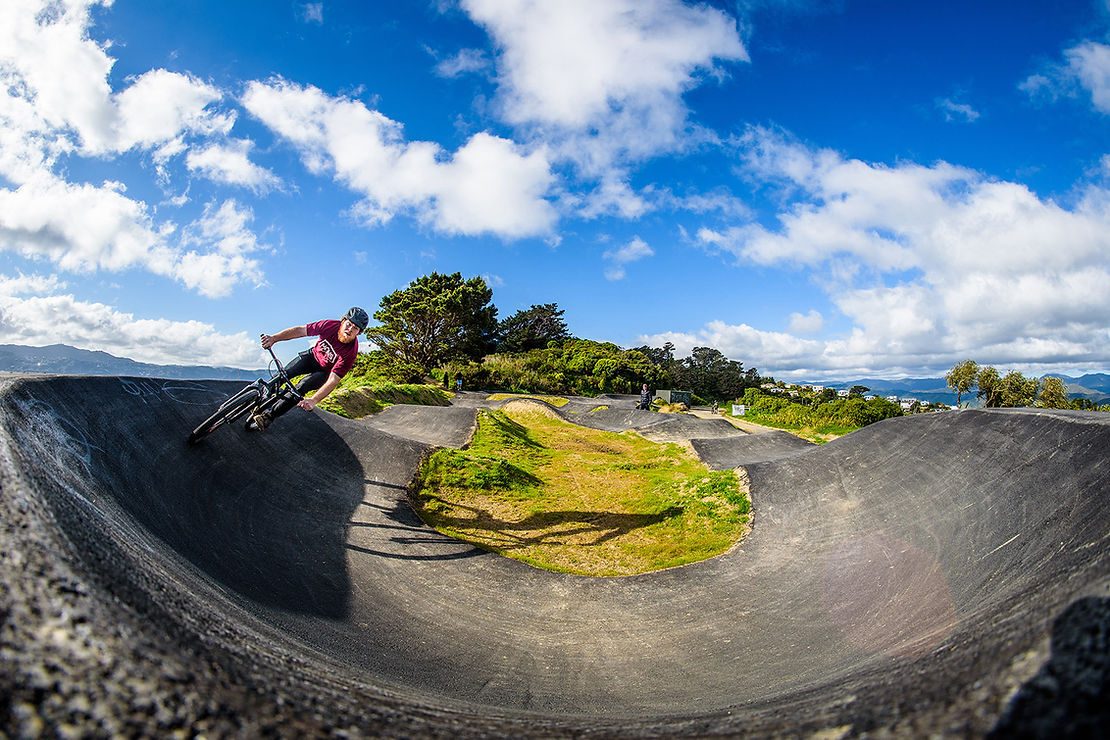The old pump track in Miramar has had a transformation. No longer mere mounds of dirt, the perfectly crafted waves are now coated with a handsome layer of dark grey asphalt. It’s part of a new wave of sealed tracks popping up around the country, following an overseas trend which has become increasingly popular in recent years.
The Miramar track is an especially nice example. Sitting in a clear space on top of the Miramar peninsula in Wellington, it provides stunning views of Mt Victoria and Haitaitai across the deep blue expanse of Evans Bay. Planes regularly fly through the space on their way into the nearby airport.
Local mountain biker Paul Gray is often found up there at the end of a busy weekend. “It’s usually a Sunday evening type thing after we’ve ridden too much in the weekend, and want somewhere to hang out and have some beers, and try some stupid stuff.” He says the track is “quite progressive” and attracts everyone from little kids to pretty handy riders. “You can sort of do anything around it; you just start linking it up and there’s lots of sneaky lines and jumps and it opens up quite a bit. I’ve seen the same kid up there every time I’ve been going up, and he’s just getting better every time, so it’s pretty good for those young guys.”
Since the pump track was sealed at the end of August, it’s been getting a lot more use, and not just from mountain bikers. Ben Wilde says he’s seen a real mix of skateboarders, kids on scooters and families with small children start using the space, as well as the dog walkers who have been going up there regularly for over 30 years. Despite the range of different interests, Ben says there’s been “zero issues” with sharing the space. He says he was “taken aback” by how popular the pump track has been since getting the layer of asphalt. “You can have 20 or 30 people up there, which is great. I think pump tracks are a hugely efficient use of space, and given the response there’s been to it, it would be great to see more of them around the city.” Ben is a co-founder of the Miramar Track Project (MTP), which was set up almost ten years ago when he and a couple of others got sick of the drive across town to Makara Peak to do their digging and riding.

Since then a tidy wee trail network has been put in through Centennial Park, built by volunteers determined to make the best of the 100-odd metres of vert on offer. The trails offer a gentle climb up on a shared-use trail and a couple of mountain bike-priority options back down, such as the long-time fan favourite Jailbreak. The first pump track at the top of the site was built about seven years ago and has been through several revamps since. The most thorough was at the end of April, when the Wellington City Council paid for a contractor to level the site and rebuild the pump track to a higher standard. Ben says the idea for a major overhaul came from Steven Peters, then a council ranger, who made the suggestion about 18 months ago. But a joking comment from Russel Garlick (another MTP co-founder) about how good it would be to have the track sealed put the idea in people’s heads.
Ben said they didn’t have any hope of raising the funds it would need, which was tens of thousands of dollars. “So it was well beyond running a few enduros and selling some sausages.” Luckily, the Wellington City Council were into the idea, and put up the $40,000 needed to get it asphalted – on top of the $16,000 they previously fronted for the April rebuild. They also had hydro seed (spray on grass seed) and other landscaping done in and around the track. Both the April overhaul and August sealing work was done by the New Zealand branch of Velosolutions, a Swiss-based company owned by Claudio Caluori – the man famous for his hilarious commentated preview runs of Downhill World Cup courses. The company have become specialists in sealed pump tracks. The New Zealand owner-partner is Rotorua-based Craig Pattle, who says Velosolutions is nearing 100 such builds worldwide over the last decade – about ten of which he has been involved in personally. He says they had to make a couple of changes to the Miramar track before they laid down the asphalt, as the seal makes it run a bit quicker.
About 80 tonnes of asphalt were required to seal the track. That work was done over a few days by a crew of dedicated volunteers, who took time off their day jobs to get involved in the hot, physical work with only free pizza (courtesy of Burkes cycles) and satisfaction in return. Velosolutions were given free reign with the design of the track, apart from a request for multiple loops to be included. They came back with something that rides well in both directions for people at all skill levels. Craig says getting the design right is a matter of trial and error, and years of pump track building experience. “We’re pretty sure we know what works by building these tracks all around the world.” He says as well as looking better, the main advantage of the asphalt was less maintenance. Dave Halliday was one of the key figures in the publicly-funded project.

The Wellington City Council project manager for parks and recreation says for the council, paying for the sealing was worthwhile because of those maintenance reductions, which takes pressure off the community, while making the track able to be used by a wider range of users, like skateboarders and scooter riders. “It’s quite apparent now that with a sealed track you get a better product, so that additional investment is worth it I feel.” He says from a council point of view, it’s important the pump tracks can be used by people from a range of age and skill levels. And there could be more asphalt pump tracks in the future, if the council’s budget allows. Dave would like to see a recently upgraded track in Tawa sealed, but there isn’t any money for it at the moment.
For Ben and the other MTP trail builders, the zero-maintenance aspect is massive. “The problem with dirt pump tracks is they deteriorate quite quickly; all the stones come through and they become quite rough. “So you basically have to constantly look after them, and when you’re a volunteer organisation, or even council, that’s not something anyone wants to sign up and do.” He would like to see the concrete area next to the track resealed with a smoother concrete, and some toilets added, but those upgrades are not on the council’s radar at the moment.
A project like this couldn’t happen without strong relationships between the trail builders and the local government. Dave says a very strong working relationship has developed over the years. “Those guys put a lot of effort in, they’re very self-motivated and we assist where we can.” Ben says the council have been very supportive. “They get frustrated with us of course, as a community, when we go and build and ride in places we’re not supposed to. But on the whole, the relationship with the community and Wellington Mountain Bike Club is really strong.” As for the trail network, there’s a feeling it wouldn’t be a good idea to put more track into the small reserve – though maintenance and planting work is ongoing. About 500 native plants a year are put into the hill by the trail building team.

Ben says the MTP is working with the council to look at trails on the western side of Miramar Peninsula. He says it’s been a real plus for the community to have the recreational space, but one of the “big tragedies” is a lack of action over the adjacent Crown land, made up of the empty Mt Crawford prison and about 76 hectares of ex-Defence Force land which was handed over to Land Information New Zealand in March. They plan to turn the vast bulk of it into a public reserve – a promise which has been made since 2011 – but the final decision is dependent on funding availability. Group manager of Crown Property John Hook says work is underway with DOC and the council to see what needs to be done to set up the reserve.
“Subject to the appropriate funding being confirmed, creating the reserve is estimated to take up to four years and the property will not be opened to the public until the work has been completed.”
Despite all that potential being locked away currently, even the small spot they have has become a real feature, Ben says. “It’s been a feature of some peoples’ decision to live out here. I know people that have just decided that Miramar’s okay now.”
Words: Michael Hayward
Images: Digby Shaw

